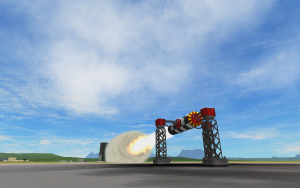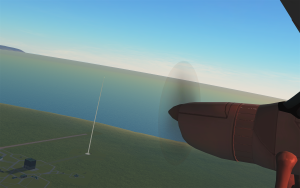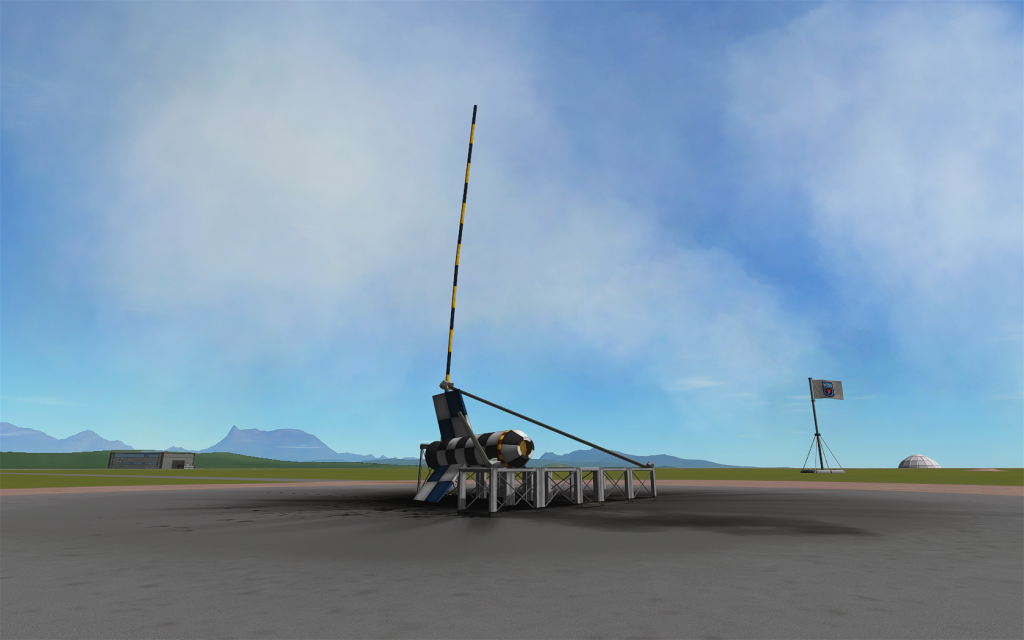 The final flight of 2017 saw a triumphant return to space with a redesigned Block I solving many of the issues that plagued the previous flight, although it also introduced some new ones. The quest continues…
The final flight of 2017 saw a triumphant return to space with a redesigned Block I solving many of the issues that plagued the previous flight, although it also introduced some new ones. The quest continues…
Tag Archive: Progeny Mk5
Dec 14 2017
Progeny Mk5 Block I Flight 3
Nov 30 2017
Progeny Mk5 Block I Booster Test
Nov 09 2017
Progeny Mk5 Block I Flight 2 Analysis
 Last week’s launch was the first complete flight to space and back of our new Block I design, which primarily features more powerful first and second stage solid-fuel booster engines. Despite the incredible record-setting apokee of 493km and being able to recover the payload afterwards (barely), many problems became apparent that have needed to be addressed. In this report we will first cover the details of the flight, then look into solutions for the problems that occurred and finally talk about how we plan to move forward.
Last week’s launch was the first complete flight to space and back of our new Block I design, which primarily features more powerful first and second stage solid-fuel booster engines. Despite the incredible record-setting apokee of 493km and being able to recover the payload afterwards (barely), many problems became apparent that have needed to be addressed. In this report we will first cover the details of the flight, then look into solutions for the problems that occurred and finally talk about how we plan to move forward.
The Flight
After delays and a scrub of the initial launch time due to weather issues, the rocket was finally launched off the pad at 01:58:00.03 UTC under command of the Automated Flight Control System. The first stage solid fuel booster kicked in at 67.226kN of thrust to propel the rocket at an initial rate of 4Gs off the pad in order to put enough aerodynamic force into effect to keep the rocket’s nose from lifting too high. Beginning at 85° the nose of the rocket reached a maximum pitch of 86.935° at 2 seconds after launch, well-within limits. Burning fuel at a rate of 39.089kg per second, the 0.625m booster propelled the rocket up to 788.124m/s over the course of its 20.42 second burn, topping out at 76.422kN of thrust. The dynamic pressure at flame-out was 139.299kPa, by far the highest sustained so far by a complete stack of the Mk5. The booster was decoupled as planned 1 second after flame-out was detected, which is when the first flight anomaly occurred.
Nov 01 2017
Progeny Mk5 Block I & II Launches Halted for Program Review
 Although the second flight of the Mk5 Block I was an incredible success, reaching nearly 500km up into space (more than twice what we hoped for), it has also brought to light numerous issues that will need to be resolved. We consider ourselves to be extremely lucky in being able to recover this rocket & until we feel confident we can do it again we won’t be launching any more. This also extends to the more-powerful Block II variant, which is directly dependent on the success of the Block I. In addition to any technical and engineering issues, the very nature of the Mk5 program will need to be rethought now that we have an idea of just how powerful the newer boosters are. We planned for the Block I to service LKO & have trouble pushing payloads beyond 250km. The Block II was therefore the heavy-lift variant that would allow science data to be gathered beyond this distance.
Although the second flight of the Mk5 Block I was an incredible success, reaching nearly 500km up into space (more than twice what we hoped for), it has also brought to light numerous issues that will need to be resolved. We consider ourselves to be extremely lucky in being able to recover this rocket & until we feel confident we can do it again we won’t be launching any more. This also extends to the more-powerful Block II variant, which is directly dependent on the success of the Block I. In addition to any technical and engineering issues, the very nature of the Mk5 program will need to be rethought now that we have an idea of just how powerful the newer boosters are. We planned for the Block I to service LKO & have trouble pushing payloads beyond 250km. The Block II was therefore the heavy-lift variant that would allow science data to be gathered beyond this distance.
Today the recovered third stage was carefully dismantled, large sections were fused together due to the heat from re-entry, but the data onboard was accessed and confirmed mostly intact, which still marks this as a successful flight. These next few days will be spent analyzing the telemetry and science data to aid in determining what our next steps will be. As the launch video released earlier shows, there were some problems during ascent that will need to be addressed.
Until we release our full report on the flight, the next Block I launch that was scheduled for 11/7 has been pushed back to no earlier than 11/22, while the Block II launch has been pushed back to no earlier than December. We very much hope to get at least one Block II off before the operational year ends on 12/15!
Oct 26 2017
Why Photos from Space are Still Hard
 Hello everyone, Drew Kerman here, Operations Director for the KSA. I’d like to take some time to explain why despite the fact that we’ve been going to space now for over three months we haven’t taken any photos from above the atmosphere and won’t be doing so for another few months at least. Although it’s true space photos would not be a huge science return and mainly be of benefit only to our PR department (do we have a PR department? I should know that) that’s not the reason. Simple fact is that our current fleet of sub-orbital rockets, the Progeny family, are not a good platform for taking photos for numerous reasons.
Hello everyone, Drew Kerman here, Operations Director for the KSA. I’d like to take some time to explain why despite the fact that we’ve been going to space now for over three months we haven’t taken any photos from above the atmosphere and won’t be doing so for another few months at least. Although it’s true space photos would not be a huge science return and mainly be of benefit only to our PR department (do we have a PR department? I should know that) that’s not the reason. Simple fact is that our current fleet of sub-orbital rockets, the Progeny family, are not a good platform for taking photos for numerous reasons.
The main reason is that because they are unguided ballistic rockets in order to help maintain stability during powered ascent their fins are slightly angled to spin the rocket up. This is a very easy way to keep a rocket flying straight and stable but because we are using the fins to induce spin rather than, say, small external thrusters, the spin rate increases throughout the entire flight while the rocket is under thrust. By the time the third stage has expended its fuel the rocket is generally spinning at a rate of ~150RPM or nearly three times per second. To get an idea of what that would look like, here is a video taken during a Progeny Mk2.1 launch where the payload was only spinning at roughly 120RPM. Any photos taken at such speeds would be extremely motion-blurred, especially given the longer exposures we would want for photos from space.
A solution to this problem comes from a technique known as a yo-yo despin, which you can see an example of in this video simulation. Progenitor engineers have already modeled a similar setup and determined it’s possible to get this to work for the Progeny rocket by removing the batteries on the upper payload truss to install two winch units that would deploy the counter-weights once the payload is in space, slowing down the spin rate so that a single camera mounted on the lower truss (the other payload position would be a battery) could get shots of various views as the rocket rotated more slowly. However to deploy the counter-weights means detaching the upper payload fairings, and that could bring about a new set of problems.
Oct 21 2017
Progeny Mk5 Block I Flight 1 Analysis
 After a full day cycle delay thanks to weather, the first Block I finally had a chance to liftoff after 4th sunrise, however it was beset by a failure of its first stage booster. The lack of ignition triggered a cascade of improper commands from the Automated Flight Control System which resulted in the premature deployment of the parachute, the second stage booster igniting and the rocket being carried almost 8km downrange to crash into the waters of the Kerblantic.
After a full day cycle delay thanks to weather, the first Block I finally had a chance to liftoff after 4th sunrise, however it was beset by a failure of its first stage booster. The lack of ignition triggered a cascade of improper commands from the Automated Flight Control System which resulted in the premature deployment of the parachute, the second stage booster igniting and the rocket being carried almost 8km downrange to crash into the waters of the Kerblantic.
Today we investigated the first stage booster, which was left lying on the launchpad, in the VAB to determine whether it was a bad ignitor or a mis-fire that triggered the failure. A bad ignitor means that the spark that should have been created to light off the solid fuel burn was not generated due to manufacturing defects. Unfortunately there is no way to test for a bad ignitor before launch – as soon as you set it off to confirm it is working it becomes useless. The most you can do is ensure that an electrical signal is reaching the ignitor by running a small charge through the wires to establish continuity but not large enough (usually) to set it off. The launch team confirmed continuity during countdown. A mis-fire means the ignitor did generate the spark meant to ignite the solid fuel but the burn either did not initiate or was stopped prematurely. In the VAB it was confirmed that the ignitor was defective, which is good as it means we don’t need a new first stage booster, just a new ignitor.
Usually with a failure like this everything would have been fine – the rocket would have remained on the launch base and we probably would have tried again just to make sure the booster was really not able to fire. However we have suffered our first logic error via the AFCS. It’s easy to clean up syntax problems that generate errors when compiled but logic errors can usually only be found during actual execution.
Oct 20 2017











